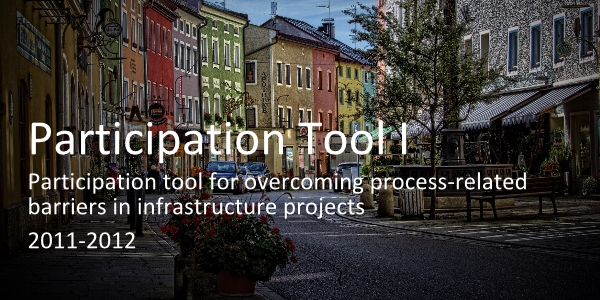Participation Tool I

Important traffic planning decisions in Austria and the European Union require good and valid databases on freight transport. Due to the different data-collection sources and procedures, this data is not complete and not entirely compatible. It shows a tendency to underestimate road-freight transport. The aim of this project was to deliver a concept for a valid, methodologically clearly conceived, ongoing and automated overall process of data consolidation and provision for freight transport as well as a prototype implementation to demonstrate feasibility.
Client: bmvit, ways2go. 3. invitation to tender
Duration: November 2010 to December 2011 (24 months)
Project partners: Mediative Solutions OG, one’s own, University of Natural Resources and Applied Life Sciences Vienna, Michaela Piruskins
Project description:
The proportion of the population who want to participate in the planning and development of their own living environment has risen steadily in recent decades. The realisation of mobility- relevant infrastructure projects is only possible if the best possible solutions are developed, which meet with sufficient acceptance by all affected and involved actors, and this requires a professional, efficient and constructive participation process.
For the first time, the project Participation Tool should enable an optimal interaction of technical and non-technical methods in participation processes by developing a technology-based planning tool to reduce planning and process-related barriers and to support or significantly improve citizen participation in mobility-relevant planning processes.
The intended project results build on the currently existing methods of participation, the legal and economic framework as well as findings from the practice of participation. In the project, the requirements of all persons, groups of persons, institutions, companies etc. involved in participation processes were collected and analysed as the basis for the conception of the participation tool. After the prototypical implementation, the participation tool was subjected to a real field test. This test under real conditions was scientifically accompanied and evaluated and led to a description of further necessary steps to enable the development of a marketable end product from the prototype of the participation tool. With regard to market opportunities, a profitability analysis was carried out and an operator model was developed.
The prototype of the participation tool to be developed consisted of two parts: The front end contained all online applications that can be used directly in the participation process. The front end corresponds to the visible part of the participation tool in the participation process. The back end represents the planning and administration level of the participation tool and thus of the entire participation process. The overall participation architecture was planned and created here, all online applications were maintained and all offline methods and the interfaces between “online” and “offline” were managed. The entire tool has a modular structure in order to be able to implement and apply different variants in terms of methods and scope depending on the requirements of a participation project.
All persons, groups of persons, institutions and companies involved benefit from the use of the participation tool: Participation processes become more constructive and efficient (time and cost savings), planning reliability increases, the planning and implementation of participation processes becomes clearer and more professional and the acceptance of developed solutions and accessibility in access to participation processes is significantly increased. In addition to public administration and politics, the participation tool also aims at mobility-relevant infrastructure projects that are implemented by private companies.
Contact: DI Dr. Alex Neumann, MA MSc
